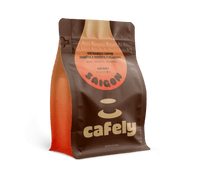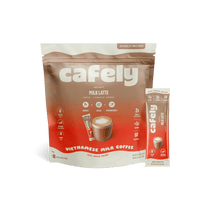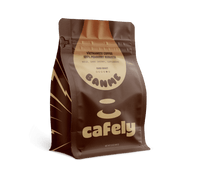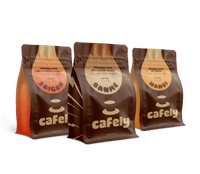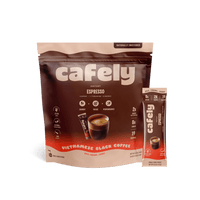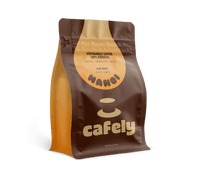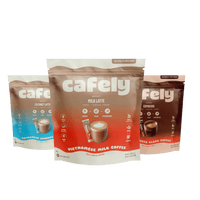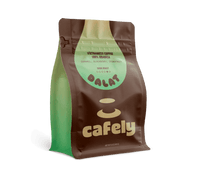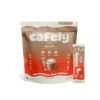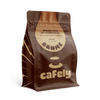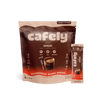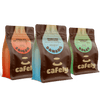Instant coffee is everywhere — but is it actually bad for you?
If you’re someone who values a quick caffeine fix, chances are you’ve reached for instant coffee at some point. It’s convenient, shelf-stable, and surprisingly affordable.
But with convenience comes skepticism, and many coffee drinkers wonder if instant coffee is somehow less healthy or more processed than brewed coffee.
But the truth is, instant coffee isn’t inherently bad for you. But, like anything, the quality and what’s added to it make all the difference.
This article breaks down what you really need to know. We’ll look at the pros and cons of instant coffee, how it’s made, what goes into it (and what doesn’t), and how it compares to freshly brewed coffee.
Is Instant Coffee Bad for You?

No, instant coffee is not bad for you. Most types of instant coffee are made from brewed coffee that has been dehydrated — nothing more. At its core, it’s still coffee. Coffee contains antioxidants, caffeine, and many of the same beneficial compounds as freshly brewed coffee.
Where things get tricky is with quality and additives. Some commercial brands add sugar, artificial creamers, flavorings, and stabilizers.
These extras, especially when consumed daily, can impact your health, particularly if you’re watching your sugar intake or avoiding ultra-processed ingredients.
But if you're drinking a plain, high-quality instant coffee with no additives, it’s a perfectly reasonable choice.
Here’s a breakdown of the key benefits and drawbacks:
Pros of Instant Coffee:
- Antioxidants — Like regular coffee, instant coffee is rich in polyphenols and other compounds that help reduce oxidative stress in the body [2].
- Lower Caffeine — Instant coffee typically contains less caffeine than brewed coffee. That’s helpful if you’re sensitive to caffeine but still want a morning ritual.
- Convenience — It’s fast, portable, and doesn’t require any equipment. Perfect for travel, work, or quick mornings.
Cons of Instant Coffee:
- Additives — Some instant blends include added sugar, artificial flavors, or hydrogenated oils. Always check the label.
- Acrylamide Exposure — This chemical forms naturally during the roasting of coffee beans. Instant coffee tends to have slightly higher levels than brewed coffee due to processing, but it’s not dangerous in typical amounts. You’d need to consume large quantities regularly for it to pose any risk.
Instant coffee is safe to drink and offers many of the same perks as brewed coffee. Just make sure you’re choosing high-quality, additive-free products, ideally with transparent sourcing and roasting methods.
What Is Instant Coffee and How Is It Made?
Many people assume instant coffee is packed with chemicals or created from synthetic ingredients. In reality, it’s made from real coffee beans — usually robusta or a blend of robusta and arabica — that are brewed, concentrated, and dried into powder or granules.
Here’s how instant coffee is made:
Step 1: Brewing the Coffee
Instant coffee starts the same way regular coffee does — with roasted and ground beans. These are brewed in massive batches using water, often at higher concentrations than you’d use for a normal cup. The goal is to extract a strong, flavorful brew that can withstand the drying process.
Different manufacturers may use slightly different brewing temperatures and steeping methods, but the result is usually the same — a dense, aromatic coffee concentrate.
Step 2: Concentrating the Brew
Once the brewed coffee is ready, it’s concentrated further by reducing the water content. This thick, syrup-like liquid is the base for making instant coffee powder or granules.
From here, there are two main methods of dehydration — spray drying and freeze drying.
1. Spray Drying
This is the most common and cost-effective way to make instant coffee. The concentrated liquid coffee is sprayed into a large chamber filled with hot air.
As the droplets fall, the heat causes the water to evaporate quickly, leaving behind dry coffee particles.
These particles are collected at the bottom as a fine powder or small granules.
Pros of spray drying:
- Faster and cheaper to produce.
- Great for large-scale production.
Drawbacks of spray drying:
- The high heat can degrade some of the coffee’s natural aroma and flavor.
- Often results in a more bitter or burnt taste compared to freeze-dried options.
2. Freeze Drying
This method is more expensive but produces a higher-quality product. The coffee concentrate is first frozen into slabs or pellets, then placed in a vacuum chamber.
Through a process called sublimation, the ice turns directly into vapor without melting, which preserves the flavor compounds and aroma much more effectively.
Pros of freeze drying:
- Retains more of the coffee’s original flavor.
- Smoother, more aromatic taste.
- No exposure to high heat.
Drawbacks of freeze drying:
- Higher production cost.
- Typically found in premium instant coffees only.
Are Chemicals Used in the Process?
No chemicals are added during the brewing or drying process of instant coffee. The only ingredients involved in making a perfect cup of coffee are coffee beans and water.
The final product is simply dried coffee, unless you're drinking a flavored version, which may contain added syrups, sweeteners, or creamers.
If you're buying instant espresso, Vietnamese-style blends, or flavored sticks, check the ingredient list. Plain, high-quality instant coffee should include nothing but coffee.
Instant Coffee vs Regular Coffee: What’s the Difference?

Instant coffee and brewed coffee come from the same beans, but how they’re processed and how they perform in your cup can be quite different. If you’re comparing the two, here’s how they stack up in the areas that matter most.
1. Caffeine Content
One of the most noticeable differences is caffeine. Instant coffee generally contains less caffeine than regular brewed coffee.
- Instant Coffee — 30 to 90 mg of caffeine per serving.
- Brewed Coffee — 70 to 140 mg per 8-oz cup.
The variation depends on serving size, brand, and preparation.
Instant coffee is often milder, making it a good option for those who want to reduce too much caffeine intake without giving up coffee altogether.
Brewed coffee, especially when made strong or served in larger portions, delivers a much higher dose of caffeine, which may be too stimulating for some.
2. Flavor
Brewed coffee usually wins in the flavor department. When you grind fresh beans and brew them with water, you retain more of the aromatic oils and flavor compounds that define coffee’s depth and complexity.
Instant coffee goes through heating and drying, which can degrade those flavors.
Spray-dried instant coffee often tastes more bitter or flat. However, freeze-dried instant coffee retains more aroma and body and can offer a closer taste to freshly brewed coffee, especially when made with high-quality beans and filtered water.
3. Nutrients and Antioxidants
Both types of coffee offer similar antioxidant benefits. Instant and brewed coffee are rich in chlorogenic acid, polyphenols, and other plant compounds that support cellular health and reduce inflammation [1].
Instant coffee may contain slightly higher concentrations of antioxidants by weight, due to the concentration process during drying. But brewed coffee, particularly from freshly ground beans, may retain a broader range of heat-sensitive nutrients, depending on how it’s prepared.
At the end of the day, both types provide notable antioxidant value, and neither one is “less healthy” in this regard.
4. Convenience
This is where instant coffee leads.
With no need for grinders, filters, or machines, instant coffee is ideal for:
- Rushed mornings before work.
- Office settings.
- Travel.
- Camping.
- Minimalist setups.
Just add hot water, stir, and drink. Brewed coffee, while often tastier, takes more time, equipment, and cleanup. For anyone who values speed and portability, instant coffee is the obvious choice.
5. Environmental Impact
Instant coffee tends to have a smaller carbon footprint than brewed coffee. Because it’s manufactured in bulk and uses less packaging and fewer energy-intensive appliances during preparation, its overall environmental impact is lower.
A brewed cup requires more energy at home, heating water, running machines, and often wasting leftover grounds.
Instant coffee, on the other hand, produces less waste per cup and uses less energy for single servings. For eco-conscious drinkers, this may be a factor worth considering.
Benefits of Instant Coffee
In addition to being convenient, instant coffee offers several health and lifestyle benefits that make it a practical option for everyday use.
1. Low in Calories
When consumed black, instant coffee is virtually calorie-free. A typical cup of instant coffee contains 1 to 2 calories, making it one of the lowest-calorie beverages you can reach for in the morning.
If you're avoiding sugar and creamers, instant coffee helps you maintain your calorie goals without sacrificing your caffeine habit.
2. Rich in Antioxidants
Instant coffee still contains many of the same antioxidants found in brewed coffee.
These include:
- Chlorogenic Acid — May help regulate blood sugar and fight inflammation.
- Polyphenols — Linked to heart improved health and metabolic support.
- Hydroxycinnamic Acids — May help neutralize oxidative stress.
Regular consumption of coffee, including instant, has been associated with benefits like reduced risk of type 2 diabetes, liver disease, and cognitive decline [2].
3. Less Caffeine, Fewer Jitters
Because it contains less caffeine, instant coffee may cause fewer side effects like anxiety, insomnia, or heart palpitations, especially for those sensitive to stimulants [3].
This makes it a good option for:
- Afternoon or evening use.
- People with caffeine sensitivity.
- Anyone trying to reduce overall caffeine intake while keeping the habit.
You still get the mental alertness, just with a milder effect.
4. Ideal for Busy Mornings and Travel
Instant coffee requires no special equipment and works anywhere you have access to hot water.
This makes it perfect for:
- Early commutes.
- Hotel stays.
- Camping or outdoor activities.
- Office desk drawers.
Single-serve packets and jars are easy to carry, and cleanup is minimal. No filters, no grinders, no leftover grounds.
5. Affordable and Shelf-Stable
Compared to buying specialty beans or frequenting cafés, instant coffee is cost-effective. A single jar can last for weeks, and individual packets cost far less than a coffee shop latte.
It also has a long shelf life, usually up to 2 years, and doesn’t go stale as quickly as ground coffee. That makes it ideal for stocking up or using occasionally without worrying about waste.
Finding the Healthiest Instant Coffee

Not all instant coffee is created equal. Some are clean and high-quality, while others are packed with sugar, artificial ingredients, or low-grade beans. If you're looking for a healthier option, here’s what to look for when scanning the label or shopping online.
1. No Added Sugar or Artificial Flavors
Start with the ingredients list. The healthiest instant coffees are made with only one ingredient — coffee.
Avoid products that include:
- Sugar or corn syrup solids.
- Artificial creamers.
- Flavored syrups.
- Hydrogenated oils.
- Chemical stabilizers.
Many “3-in-1” style packets and flavored portions contain these additives, which can drive up the calorie count and reduce overall quality. If you want flavor, it's better to add milk and sweetener separately so you control what goes into your cup.
2. Organic or Non-GMO Beans
Choose instant coffee made from organic or non-GMO beans when possible. These are among the best healthy coffee options, as organic certification means the coffee was grown without synthetic pesticides or fertilizers, and non-GMO labeling helps ensure a cleaner crop.
While instant coffee is less likely to carry pesticide residue than fresh produce, organic beans still tend to reflect better sourcing, safer farming practices, and cleaner processing.
If you’re looking for a clean, high-quality instant coffee, Cafely’s Vietnamese Coffee 2.0 is a strong pick.
It’s made with:
- Freeze-dried coffee for better flavor and retention.
- A smooth blend of arabica and robusta beans.
- No added sugars, flavors, or creamers.
- Single-serve convenience with a bold, authentic taste.
Cafely’s instant coffee line offers a minimal ingredient list, solid sourcing, and a taste profile that works well black or with milk. It’s ideal for people who want a cleaner, faster brew without sacrificing quality.
Other instant options in the Cafely lineup include stronger dark roasts and balanced blends that are perfect for both beginners and long-time coffee drinkers.
3. Freeze-Dried for Better Nutrient Retention
Instant coffee can be made using spray drying or freeze drying. Spray drying is more common because it’s faster and cheaper, but it uses high heat, which can degrade the coffee’s natural antioxidants and alter its flavor.
Freeze-drying preserves more of the original aroma and beneficial plant compounds. It also results in better-tasting granules that dissolve easily and brew more like a fresh cup.
If the label mentions “freeze-dried” or highlights low-heat processing, that’s a good sign. These versions typically cost a bit more but deliver a cleaner, smoother cup with more nutritional value.
4. Mold-Tested or Lab-Tested Options
Coffee beans can sometimes be contaminated with mycotoxins — compounds produced by mold during improper storage. While the risk is low for most commercial brands, some health-conscious consumers prefer lab-tested options to minimize exposure.
Look for brands that perform third-party testing or highlight mold-free or toxin-screened claims. This is especially relevant for those who drink coffee daily and want peace of mind around product safety.
You might also see references to testing for:
- Heavy metals.
- Acrylamide levels.
- Residual solvents (rare in clean products).
While not always necessary, these tests can indicate higher manufacturing standards and attention to quality control.
FAQs: Is Instant Coffee Bad for You?
Want to learn more about instant coffee?
Here are 10 quick, evidence-based answers to help you decide if instant coffee fits your routine.
1. Which Coffee Is Better, Brewed Or Instant?
Brewed coffee usually tastes richer, but instant coffee is faster, easier, and more convenient.
2. What Is The Healthiest Coffee To Drink?
Black coffee without sugar, whether instant or brewed, is the healthiest choice.
3. Is Instant Coffee Bad For Cholesterol?
No. Instant coffee contains lower levels of cafestol than unfiltered brewed coffee, which makes it cholesterol-friendly.
4. How Often Can I Drink Instant Coffee?
You can drink it daily, as long as you stay within your personal caffeine limit.
5. Is Too Much Coffee Bad For Your Heart?
Too much caffeine in your daily cup may increase your heart rate — moderation is key.
6. Is Coffee Healthy For The Kidneys?
Yes, in moderate amounts. If you have kidney conditions, talk to your doctor first.
7. What Are The Disadvantages Of Instant Coffee?
Some types include additives or flavorings, and the taste may be milder than brewed coffee.
8. Which Instant Coffee Has Less Acrylamide?
Freeze-dried and light-roast instant coffees tend to have lower acrylamide levels.
9. Which Is Healthier, Filter Coffee Or Instant Coffee?
Filter coffee may offer slightly more antioxidants, but both can be healthy options.
10. How Much Caffeine Is In Instant Coffee, Nescafé?
Nescafé instant coffee usually contains about 60 to 80 mg of caffeine per cup, depending on the variety.
References:
- Kobylińska, Z., Biesiadecki, M., Kuna, E., Galiniak, S., & Mołoń, M. (2025). Coffee as a Source of Antioxidants and an Elixir of Youth. Antioxidants, 14(3), 285.
- Kolb, H., Martin, S., & Kempf, K. (2021). Coffee and Lower Risk of Type 2 Diabetes: Arguments for a Causal Relationship. Nutrients, 13(4), 1144.
- Cappelletti, S., Daria, P., Sani, G., & Aromatario, M. (2015). Caffeine: Cognitive and physical performance enhancer or psychoactive drug? Current Neuropharmacology, 13(1), 71–88.
